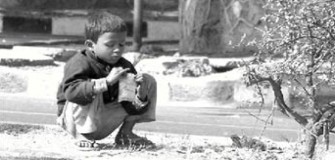UNICEF's report concluding that child malnutrition in India is comparable to sub-Saharan Africa comes as no surprise to all those working on food security in India. It may offend the sensibilities of those for whom 'India shining' was an attractive though unrealistic projection, but there is nothing on the horizon but gloom for the poor.
When the People's Union for Civil Liberties (PUCL) case started in 2001, there were starvation deaths reported throughout the country. The active intervention of the Supreme Court enthused many, and put the issue of food security on the centre stage. I have no doubt that had the Supreme Court not intervened, the thrust of globalisation, privatisation and structural adjustments would have resulted in the closure of the public distribution system and the curtailment of the midday meal scheme and the integrated child development scheme (ICDS). When Chief Justice Kirpal was on the verge of retirement, he asked for an assessment of what had been achieved, and I said that we may not have gone ahead for all these years but the court has certainly stemmed the rot.
Statistical jugglery
Anxious to show that globalisation was working not only for the rich but also for the poor, the World Bank organised a seminar of selected economists, all of whom wrote papers claiming that poverty in India had come down from 36 per cent to 22 per cent. This was published in a special report of the Economic and Political Weekly.
This conclusion was thereafter widely criticised. The most trenchant criticism came from Professor Utsa Patnaik of Jawaharlal Nehru University, in her article, The Republic of Hunger. On the basis of the NSS data on calorie intake for 1999-2000, Professor Patnaik found that 70 per cent of the Indian population was at or below the poverty line fixed by the Planning Commission in 1979 - at 2400 calories per person per day. This was a shocking condemnation of the manner in which India was developing. She also calculated that an average family of five was consuming at least 200 kg of grain less in a year than 50 years ago. Food grains were available but the poor did not have the money to purchase them.
The debate over the extent of poverty in India made us look at the alternative Planning Commission poverty line in terms of cash. That made interesting reading. The latest figures for 2000-2001 were Rs.11 per person per day in the rural areas and Rs.17 in Delhi. A clerk in any office of Delhi would spend that amount of money travelling to and from work by bus! The international poverty line is two dollars a day. Yet in India, a country which swears by globalisation, the poverty line remains at 40 cents a day. Thus, by the statistical jugglery of artificially lowering the poverty line, India hopes to do away with poor people altogether!

![]() The Supreme Court intervened in the Integrated Child Development Scheme, holding the central government accountable for the implementation of its own scheme requiring an anganwadi centre for every 1000 of the population. Against 12 lakh anganwadi centres needed, the central government had sanctioned money only for six lakh centres. Even these were not functioning in many areas. Though the court directed the government to implement its scheme fully, the finance minister made no allocation in the most recent budget.
The Supreme Court intervened in the Integrated Child Development Scheme, holding the central government accountable for the implementation of its own scheme requiring an anganwadi centre for every 1000 of the population. Against 12 lakh anganwadi centres needed, the central government had sanctioned money only for six lakh centres. Even these were not functioning in many areas. Though the court directed the government to implement its scheme fully, the finance minister made no allocation in the most recent budget.
Globalisation's mantra
Then the UN Special Rapporteur on the Right to Food, Jean Ziegler, visited India in August last year and made his report to UN. He found that "levels of malnutrition and poverty remain very high and food insecurity has increased since the 1990s." He found "one of the highest levels of child malnutrition in the world, higher than most countries in Sub-Saharan Africa". He calculated that 80 per cent of the Indian population was living on less than two dollars per day. He saw signs of increased concentration in land ownership and increased landlessness. He reported over 250 cases of starvation deaths from many parts of India and in particular from the tea gardens in West Bengal. He found hunger rampant among the dalits and tribals. He personally witnessed practices of casteism and untouchability in villages of Orissa. He concluded that "India was not currently on track to achieve the goals set in relation to malnutrition and under nourishment in the UN's Millennium Development Goals.
Globalisation has one mantra: subsidies are bad. However, without massive food subsidies the poor cannot purchase grains at all. To tackle the spectre of starving India, the government needs to push up its financial commitments from one per cent to two per cent GDP. Only then can we hope for any change.
























